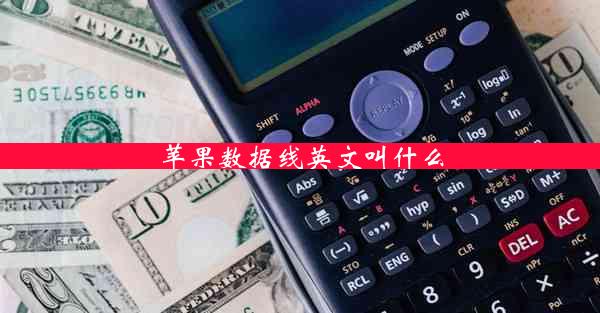苹果数据线英文叫什么
 telegram中文版
telegram中文版
硬件:Windows系统 版本:11.1.1.22 大小:9.75MB 语言:简体中文 评分: 发布:2020-02-05 更新:2024-11-08 厂商:telegram中文版
 telegram安卓版
telegram安卓版
硬件:安卓系统 版本:122.0.3.464 大小:187.94MB 厂商:telegram 发布:2022-03-29 更新:2024-10-30
 telegram ios苹果版
telegram ios苹果版
硬件:苹果系统 版本:130.0.6723.37 大小:207.1 MB 厂商:Google LLC 发布:2020-04-03 更新:2024-06-12
跳转至官网

Introduction to Apple Data Cables
Apple Inc., a leading technology company, has produced a wide range of products that have become integral parts of our daily lives. One such essential accessory is the Apple data cable, which serves as the bridge between your Apple devices and the world of data transfer. Understanding the terminology used for these cables can help users make informed decisions when purchasing or troubleshooting.
What is an Apple Data Cable?
An Apple data cable, often referred to as a Lightning cable, is a proprietary cable designed by Apple for its range of mobile devices, including the iPhone, iPad, and iPod Touch. It is used for charging and transferring data between these devices and computers or other compatible devices. The cable features a Lightning connector at one end and a USB connector at the other, allowing for seamless connectivity.
Understanding the Term Lightning Cable
The term Lightning cable is the most commonly used name for the Apple data cable. It was introduced with the release of the iPhone 5 in 2012, replacing the older 30-pin dock connector. The name Lightning reflects the cable's compact and symmetrical design, which allows it to be inserted into the device in any orientation.
Why Use an Apple Data Cable?
There are several reasons why an Apple data cable is essential for Apple device users:
- Charging: The cable is the primary means of charging Apple devices, ensuring that they are ready for use whenever needed.
- Data Transfer: Users can transfer files, photos, and other data between their Apple devices and computers or other devices.
- Syncing: The cable is used to sync content, such as music, movies, and apps, from a computer to an Apple device.
Types of Apple Data Cables
While the term Lightning cable is widely used, there are different types of these cables available:
- Standard Lightning Cable: The most common type, used for everyday charging and data transfer.
- Lightning to USB Cable: This cable has a USB connector on the other end, making it compatible with a wider range of devices.
- Lightning to USB 3 Camera Adapter: Designed for transferring photos and videos from a camera to an Apple device.
Choosing the Right Apple Data Cable
When selecting an Apple data cable, consider the following factors:
- Compatibility: Ensure the cable is compatible with your specific Apple device model.
- Length: Choose a length that suits your needs, whether you need a short cable for convenience or a longer one for flexibility.
- Quality: Opt for a cable from a reputable manufacturer to ensure durability and reliability.
Common Issues with Apple Data Cables
Despite their reliability, Apple data cables can sometimes encounter issues:
- Fraying: Over time, the cable may show signs of wear and tear, leading to fraying.
- Connectivity Problems: Issues with the cable's connectors can cause connectivity problems.
- Faulty Cables: Sometimes, the cable itself may be faulty, requiring replacement.
How to Fix Common Apple Data Cable Issues
If you encounter problems with your Apple data cable, here are some troubleshooting steps:
- Inspect the Cable: Check for any visible damage, such as fraying or bent connectors.
- Clean the Connectors: Use a soft cloth to clean the connectors on both ends of the cable.
- Try a Different Cable: If possible, test the cable with another device to determine if the issue is with the cable or the device.
- Replace the Cable: If the above steps do not resolve the issue, it may be time to replace the cable.
Conclusion
The Apple data cable, or Lightning cable, is a crucial accessory for Apple device users. Understanding its purpose, types, and common issues can help you make the most of this essential tool. Whether you're charging your device or transferring data, a reliable Apple data cable is an investment worth making.












